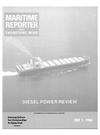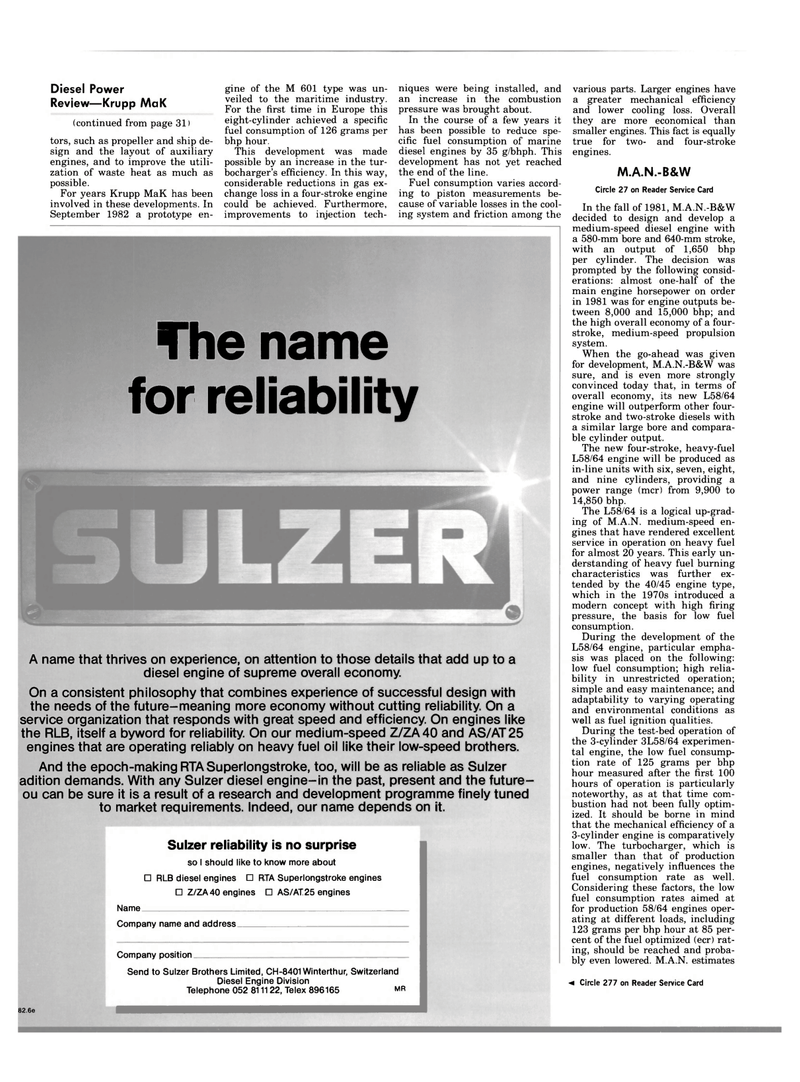
Page 30: of Maritime Reporter Magazine (July 1984)
Read this page in Pdf, Flash or Html5 edition of July 1984 Maritime Reporter Magazine
Diesel Power
Review—Krupp MaK (continued from page 31) tors, such as propeller and ship de- sign and the layout of auxiliary engines, and to improve the utili- zation of waste heat as much as possible.
For years Krupp MaK has been involved in these developments. In
September 1982 a prototype en- gine of the M 601 type was un- veiled to the maritime industry.
For the first time in Europe this eight-cylinder achieved a specific fuel consumption of 126 grams per bhp hour.
This development was made possible by an increase in the tur- bocharger's efficiency. In this way, considerable reductions in gas ex- change loss in a four-stroke engine could be achieved. Furthermore, improvements to injection tech- niques were being installed, and an increase in the combustion pressure was brought about.
In the course of a few years it has been possible to reduce spe- cific fuel consumption of marine diesel engines by 35 g/bhph. This development has not yet reached the end of the line.
Fuel consumption varies accord- ing to piston measurements be- cause of variable losses in the cool- ing system and friction among the
The name for reliability
A name that thrives on experience, on attention to those details that add up to a diesel engine of supreme overall economy.
On a consistent philosophy that combines experience of successful design with the needs of the future-meaning more economy without cutting reliability. On a service organization that responds with great speed and efficiency. On engines like the RLB, itself a byword for reliability. On our medium-speed Z/ZA40 and AS/AT 25 engines that are operating reliably on heavy fuel oil like their low-speed brothers.
And the epoch-making RTASuperlongstroke, too, will be as reliable as Sulzer adition demands. With any Sulzer diesel engine-in the past, present and the future- /ou can be sure it is a result of a research and development programme finely tuned to market requirements. Indeed, our name depends on it.
Sulzer reliability is no surprise so I should like to know more about • RLB diesel engines • RTA Superlongstroke engines • Z/ZA 40 engines • AS/AT25 engines
Name
Company name and address
Company position
Send to Sulzer Brothers Limited, CH-8401 Winterthur, Switzerland
Diesel Engine Division
Telephone 052 811122, Telex 896165 mr various parts. Larger engines have a greater mechanical efficiency and lower cooling loss. Overall they are more economical than smaller engines. This fact is equally true for two- and four-stroke engines.
M.A.N.-B&W
Circle 27 on Reader Service Card
In the fall of 1981, M.A.N.-B&W decided to design and develop a medium-speed diesel engine with a 580-mm bore and 640-mm stroke, with an output of 1,650 bhp per cylinder. The decision was prompted by the following consid- erations: almost one-half of the main engine horsepower on order in 1981 was for engine outputs be- tween 8,000 and 15,000 bhp; and the high overall economy of a four- stroke, medium-speed propulsion system.
When the go-ahead was given for development, M.A.N.-B&W was sure, and is even more strongly convinced today that, in terms of overall economy, its new L58/64 engine will outperform other four- stroke and two-stroke diesels with a similar large bore and compara- ble cylinder output.
The new four-stroke, heavy-fuel
L58/64 engine will be produced as in-line units with six, seven, eight, and nine cylinders, providing a power range (mcr) from 9,900 to 14,850 bhp.
The L58/64 is a logical up-grad- ing of M.A.N, medium-speed en- gines that have rendered excellent service in operation on heavy fuel for almost 20 years. This early un- derstanding of heavy fuel burning characteristics was further ex- tended by the 40/45 engine type, which in the 1970s introduced a modern concept with high firing pressure, the basis for low fuel consumption.
During the development of the
L58/64 engine, particular empha- sis was placed on the following: low fuel consumption; high relia- bility in unrestricted operation; simple and easy maintenance; and adaptability to varying operating and environmental conditions as well as fuel ignition qualities.
During the test-bed operation of the 3-cylinder 3L58/64 experimen- tal engine, the low fuel consump- tion rate of 125 grams per bhp hour measured after the first 100 hours of operation is particularly noteworthy, as at that time com- bustion had not been fully optim- ized. It should be borne in mind that the mechanical efficiency of a 3-cylinder engine is comparatively low. The turbocharger, which is smaller than that of production engines, negatively influences the fuel consumption rate as well.
Considering these factors, the low fuel consumption rates aimed at for production 58/64 engines oper- ating at different loads, including 123 grams per bhp hour at 85 per- cent of the fuel optimized (ecr) rat- ing, should be reached and proba- bly even lowered. M.A.N, estimates
M Circle 277 on Reader Service Card 82.6e

 29
29

 31
31
